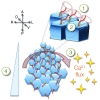Salient features of the ciliated organ of asymmetry
- PMID: 24481178
- PMCID: PMC4199803
- DOI: 10.4161/bioa.28014
Salient features of the ciliated organ of asymmetry
Abstract
Many internal organs develop distinct left and right sides that are essential for their functions. In several vertebrate embryos, motile cilia generate an asymmetric fluid flow that plays an important role in establishing left-right (LR) signaling cascades. These 'LR cilia' are found in the ventral node and posterior notochordal plate in mammals, the gastrocoel roof plate in amphibians and Kupffer's vesicle in teleost fish. I consider these transient ciliated structures as the 'organ of asymmetry' that directs LR patterning of the developing embryo. Variations in size and morphology of the organ of asymmetry in different vertebrate species have raised questions regarding the fundamental features that are required for LR determination. Here, I review current models for how LR asymmetry is established in vertebrates, discuss the cellular architecture of the ciliated organ of asymmetry and then propose key features of this organ that are critical for orienting the LR body axis.
Keywords: Kupffer’s vesicle; Left-right asymmetry; calcium ion flux; cilia; congenital heart defects; gastrocoel roof plate; posterior notochordal plate.
Figures


References
Publication types
MeSH terms
Substances
Grants and funding
LinkOut - more resources
Full Text Sources
Other Literature Sources
